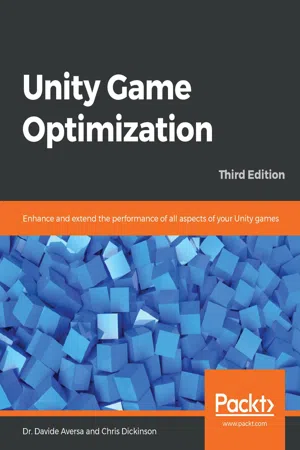
Unity Game Optimization
Enhance and extend the performance of all aspects of your Unity games, 3rd Edition
- 404 pages
- English
- ePUB (mobile friendly)
- Available on iOS & Android
Unity Game Optimization
Enhance and extend the performance of all aspects of your Unity games, 3rd Edition
About this book
Get up to speed with a series of performance-enhancing coding techniques and methods that will help you improve the performance of your Unity applications
Key Features
- Optimize graphically intensive games using the latest features of Unity such as Entity Component System (ECS) and the Burst compiler
- Explore techniques for solving performance issues with your VR projects
- Learn best practices for project organization to save time through an improved workflow
Book Description
Unity engine comes with a great set of features to help you build high-performance games. This Unity book is your guide to optimizing various aspects of your game development, from game characters and scripts, right through to animations.
You'll explore techniques for writing better game scripts and learn how to optimize a game using Unity technologies such as ECS and the Burst compiler. The book will also help you manage third-party tooling used with the Unity ecosystem. You'll also focus on the problems in the performance of large games and virtual reality (VR) projects in Unity, gaining insights into detecting performance issues and performing root cause analysis. As you progress, you'll discover best practices for your Unity C# script code and get to grips with usage patterns. Later, you'll be able to optimize audio resources and texture files, along with effectively storing and using resource files. You'll then delve into the Rendering Pipeline and learn how to identify performance problems in the pipeline. In addition to this, you'll learn how to optimize the memory and processing unit of Unity. Finally, you'll cover tips and tricks used by Unity professionals to improve the project workflow.
By the end of this book, you'll have developed the skills you need to build interactive games using Unity and its components.
What you will learn
- Apply the Unity Profiler to find bottlenecks in your app, and discover how to resolve them
- Discover performance problems that are critical for VR projects and learn how to tackle them
- Enhance shaders in an accessible way, optimizing them with subtle yet effective performance tweaks
- Use the physics engine to keep scenes as dynamic as possible
- Organize, filter, and compress art assets to maximize performance while maintaining high quality
- Use the Mono framework and C# to implement low-level enhancements that maximize memory usage and prevent garbage collection
Who this book is for
The book is intended for intermediate Unity game developers who wants to maximize the performance of their game. The book assumes familiarity with C# programming.
Frequently asked questions
- Essential is ideal for learners and professionals who enjoy exploring a wide range of subjects. Access the Essential Library with 800,000+ trusted titles and best-sellers across business, personal growth, and the humanities. Includes unlimited reading time and Standard Read Aloud voice.
- Complete: Perfect for advanced learners and researchers needing full, unrestricted access. Unlock 1.4M+ books across hundreds of subjects, including academic and specialized titles. The Complete Plan also includes advanced features like Premium Read Aloud and Research Assistant.
Please note we cannot support devices running on iOS 13 and Android 7 or earlier. Learn more about using the app.
Information
Section 1: Base Scripting Optimization
- Chapter 1, Evaluating Performance Problems
- Chapter 2, Scripting Strategies
Evaluating Performance Problems
- How to gather profiling data using the Unity Profiler
- How to analyze Profiler data for performance bottlenecks
- Techniques to isolate a performance problem and determine its root cause
Gathering profiling data using the Unity Profiler
- CPU consumption (per-major subsystem)
- Basic and detailed rendering and GPU information
- Runtime memory allocations and overall consumption
- Audio source/data usage
- Physics engine (2D and 3D) usage
- Network messaging and operation usage
- Video playback usage
- Basic and detailed user interface performance
- Global Illumination (GI) statistics
Launching the Profiler
- Local instances of the application, either through the Editor or a standalone instance
- Local instances of a WebGL application running in a browser
- Remote instances of the application on an iOS device (for example, iPhone or iPad)
- Remote instances of the application on an Android device (for example, an Android tablet or phone)
- Profiling the E...
Table of contents
- Title Page
- Copyright and Credits
- Dedication
- About Packt
- Contributors
- Preface
- Section 1: Base Scripting Optimization
- Evaluating Performance Problems
- Scripting Strategies
- Section 2: Graphical Optimizations
- The Benefits of Batching
- Optimizing Your Art Assets
- Faster Physics
- Dynamic Graphics
- Section 3: Advance Optimizations
- Optimizations for Virtual and Augmented Reality
- Masterful Memory Management
- The Data-Oriented Technology Stack
- Tactical Tips and Tricks
- Other Books You May Enjoy